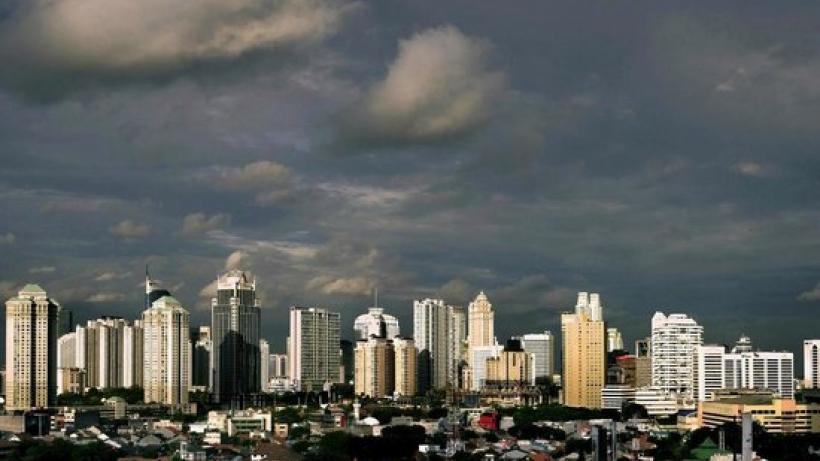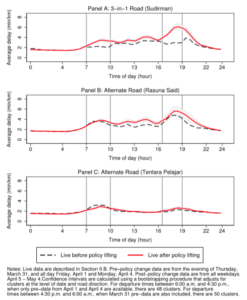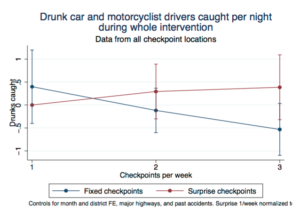
Unexpected side-effects: Urban policies and market responses
Should cities invest in public transport systems, even if they might slow growth? Can an HOV lane reduce congestion when drivers circumvent it? Is unpredictability of police enforcement a good thing for reducing drunk-driving? These and other surprising facts were presented at the recent IGC mini-cities conference. Research highlighted below showcases the importance of accounting for market and behavioral responses in designing policies.
Policymakers across the developing world are at a critical juncture, where appropriate and well implemented urban policy has the potential to unlock a sustainable economic growth process that can rapidly lift millions out of poverty. At the same time, cutting edge research is shedding new light on policy decisions needed to make a success of urbanisation. To further crystalise an agenda around the study of cities in developing countries, the IGC hosted its second Cities Mini-Conference at Harvard University on 5 May 2017. One key theme emerging from the conference was the importance of effective policies to manage and maintain urban mobility in developing cities.
Cities drive growth because of their ability to bring together firms and workers in an environment that promotes scale and specialisation. Urban mobility is at the centre of this process, enabling firms and workers to access the large and specialised markets for goods and labour that underpin productivity. However, in many developed and developing cities, nonexistent walkways, crippling traffic jams and high costs of transport services limit both the liveability and the productivity of the city.
In this context, evidence-based policy to improve both public transport and regulate private vehicle use can yield significant benefits for citizens in developing cities.
Evidence on the effects of subway systems
Evidence on the effects of various shared public transport systems is crucial in helping policymakers prioritise different investments. Many developing cities are looking to mass transit systems such as subway systems to help alleviate congestion, but evidence of the impact of such investments is limited. At the conference, Matthew Turner and Marco Gonzalez-Navarro presented two interrelated papers on the effects of subways on urban growth and pollution. Using data on all subway systems across the world opened between 1970 and 1990, they find that there is a strong cross-sectional correlation between subway expansion and population growth. However, their research casts doubt on whether subways are a cause of urban growth, or simply a consequence of it.
Introduction of a subway system in a city is associated with a 5% reduction in polluted air particles
Looking at data on cities as they develop over time, they find that introducing new urban subways decentralises economic activity in cities. These investments have limited impact on encouraging aggregate urban growth, measured through population growth and data on night lights – a common proxy for economic activity. This somewhat surprising result may be due to the disparate motivations that cities may have for investing in subways. Some cities see subways as a means of encouraging economic activity in growing cities, whilst in other cities, subways are introduced precisely because the city is in decline – giving rise to a negative relationship between subways and growth.
At the same time, Turner and Gonzalez-Navarro do find a significant impact of subway investments on urban sustainability in the form of air pollution levels. They find that the introduction of a subway system in a city is associated with a 5% reduction in polluted air particles when compared to 18 months before these systems are in place. This effect persists for up to 8 years, revealing a significant and long lasting effect of investments in low-emission shared transport systems on urban sustainability. Based on WHO estimates, the economic value of this reduction in pollution can be up to $10 per subway trip.
Improving effectiveness of congestion and safety regulation
Alongside investments in public transport infrastructure, a growing concern for policymakers is how to regulate private vehicle use to reduce congestion and improve safety in cities. Research at the conference provided key insights into the effectiveness of such regulations. Gabriel Kriendler presented a paper on the impact of the elimination of the ‘3-in-1’ traffic restriction in Jakarta. This policy mandated that all cars driving on particular popular urban roads had to have at least three passengers in the car in order to be able to drive – a ‘high-occupancy vehicle’ (HOV) restriction. As a result, a ‘market’ for excess passengers was created, whereby rich commuters would pay people to sit in their cars with them in order to circumvent the restriction. Many citizens believed that this policy was therefore largely ineffective in reducing traffic. However, this study reveals that removing the restriction greatly increased traffic on HOV-restricted roads. Interestingly, this was not driven by a decrease in traffic on alternative routes, suggesting that the repealing of the policy served not to shift traffic from one road to another, but to increase the total amount of traffic in the city as a whole.

Professor Abhijit Banerjee presented a paper examining the effective use of limited policy resources to curtail drinking and driving in Indian cities. The study found that the frequency and placement of policy checks plays a significant role in identifying and deterring unsafe behavior. The paper highlights that, in line with theoretical predictions, for higher frequency police checks it becomes increasingly important to randomize the location of checks. Without this, drivers quickly learned the locations and choose routes avoiding them. The importance of ‘keeping people guessing’ on police checks by randomising location and even reducing the frequency of checks had a limiting effect on dangerous driving behaviour even after the policy of police checks ended. By making checks more unpredictable, drivers take longer to realise the policy has ended.

A full programme of the day, alongside relevant working papers for research presented can be found here.

